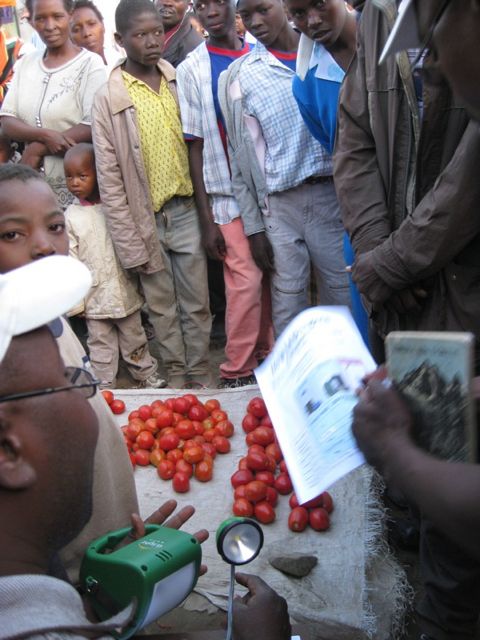Market Trial: Selling Off-Grid Lighting Products in Rural Kenya
Jennifer Tracy†, Peter Alstone†, Arne Jacobson† and Evan Mills*
† Schatz Energy Research Center, Humboldt State University
* Lawrence Berkeley National Laboratory, University of California
Lumina Project Technical Report #6
June 21, 2010
Download Full Report [PDF]

In this study, we performed a market trial of off-grid LED lighting products in Maai Mahiu, a rural Kenyan town. Our goals were to assess consumer demand and consumer preferences with respect to off-grid lighting systems and to gain feedback from off-grid lighting users at the point of purchase and after they have used to products for some time. Key findings from this work include the following:
- There was modest demand for the lamp products available through the Market Trial, with 23 systems sold to 164 shop visitors (14%) over a period of 9 months.
- People preferred the performance and features of lamps designed to provide room lighting over those that were perceived primarily as task lights, despite the higher price of the former products.
- One-quarter of the purchasers lived in electrified homes, two-thirds of whom retained the lamps in their home while the remaining used them in their non-electrified place of business. This suggests that people in electrified homes still see considerable value in off-grid lighting for use during power outages or other circumstances.
- When given an option to purchase the grid-rechargeable LED lamp at a cheaper price without the solar charger option, 100% of the purchasers paid the higher cost to purchase the solar charger. This result contrasts with previous findings from prior work reported in Lumina Technical Report #3; it should be noted that the sample size in both cases was relatively small.
- In follow up surveys completed a number of months after the initial purchase, 86% of buyers reported that the LED lamp fully replaced a pre-existing kerosene lamp. The remaining 14% reported that the LED lamp partially replaced a kerosene lamp.
- Six-months after the start of the trial, the people who purchased LED lamps reported using the solar option to charge their lamp more than 90% of the time.
- None of the purchasers of the LED lamp products reported significant levels of dissatisfaction with their lamps, and none elected to return their lamp for a full refund when presented with this option approximately six months after they had purchased the lamps.
- Reasons for low sales appear to include a combination of contextual factors combined with suboptimal product marketing, including:
- Product affordability; most potential buyers were not able to afford the products and relatively few had access to financing
- Low purchasing power due to a persistently bad economy during the trial period
- General suspicions about LED quality caused by prior experiences of potential customers with low-grade products
- Potentially ineffective marketing because the sales team was relatively inexperienced, the sales literature was printed only in English, and sales took place during the daytime when it was difficult to see how the lights performed
- Potential reluctance to purchase due to a perception that the warranty period (six months) was too short and because some types of spare parts were not available
- Possible suppression of demand that occurred when community members became aware of a broader set of attractive products that were not available through the sales trial; this awareness occurred late in the trial and did not affect the first seven months of the effort
- Unavailability of products for sale; in one case a product supply ran out and additional pieces were not available for restocking
9. Market trial tests should include a diversity of product types; it is further important to anticipate and eliminate potential, and often unforeseen, impediments to sales.
Acknowledgments: This work was funded by The Rosenfeld Fund of the Blum Center for Developing Economies at UC Berkeley, through the U.S. Department of Energy under Contract No. DE-AC02-05CH11231. Art Rosenfeld has been a key supporter of this work. We wish to extend special thanks to Maina Mumbi for the use of his shop in Kenya and his business expertise. We would also like to thank Samuel Chege and Lucy Mungai for their daily efforts as lamp sales representatives.
